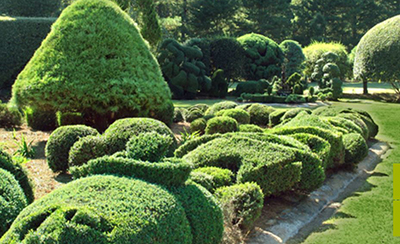The Pearl Fryar Topiary Garden, (below) in Bishopville, South Carolina, is an award-winning three-acre garden created and designed over the years by topiary artist Pearl Fryar.
Self-taught and armed with a hedge trimmer, Fryar, 82, worked for more than 20 years to create and maintain remarkable and dazzling topiaries from plants that were often salvaged from a local nursery.
When the garden needed some upkeep, topiary artist Mike Gibson stepped in.

When one story appears to be ending, someone else stokes the embers to keep it going.
That the role of Mike Gibson, a self-taught “property artist”, topiarist, and entrepreneur. He’s spent some 20 years beautifying residential and community spaces.
We spoke with him to learn about his work in topiary arts and his plans to sustain the legacy of Pearl Fryar, an acclaimed self-taught topiary artist living in South Carolina.
When did you realize topiary arts was what you wanted to do?
Gibson: For the past 15 years, I’ve worked in sales—I ran the number one Staples store in the country.
But I’ve been what I call a “property artist”, (what some call the “topiary arts”), since I was seven.
My father made sure we were always focused on something, because when you get distracted, trouble finds you. We had the best yard on the entire street.
Nobody had a yard like “The Gibsons”. I started out cutting grass and clipping bushes. By 10 I was servicing my neighbors and by 12 I was doing work across town.
Revitalizing the landscape changes people’s lives.
I grew up in Youngstown, Ohio, what many knew as a “murder capital”.
But I was like, “how about ‘topiary capital?’” I wanted to beautify my city and change that narrative by creating more beautiful spaces.
Revitalizing the landscape changes people’s lives. To date, I’ve created 330 topiaries in Youngstown, in honor of its area code.
How did you meet Pearl Fryar?
Gibson: Back in 2014, I showed my father my latest topiary and he immediately said “this looks like Pearl Fryar’s work”.
I didn’t know who Pearl was at the time but googled him and my life changed.
I met Pearl back in 2016. He was the only Black topiary artist doing this.
In 2019, I left “Corporate America” when I realized that I needed to focus on myself and my own happiness. I wanted to make things more beautiful.
Once I realized what my life’s purpose was, I pursued it. I put Pearl Fryar’s legacy on my back and continued to honor that.
Pearl thought his story was ending but I made sure it wouldn’t.
I met Pearl in 2016, but in December 2020, I saw a post on Facebook with recent pictures of the garden and it looked unkempt. I told my wife I had to do something.
What was that?
 Gibson: On March 20, 2021, I visited Pearl to restore his garden and I learned he needed a topiary artist.
Gibson: On March 20, 2021, I visited Pearl to restore his garden and I learned he needed a topiary artist.
It was because of a grant from the Central Carolina Community Foundation that we were able to restore the garden, set up preservation, and create an advisory team to oversee long-term preservation.
Pearl thought his story was ending but I made sure it wouldn’t.
Can you share some of your favorite topiary techniques?
Gibson: The techniques that Pearl uses are highly classified, likely stuff that he will take to his grave.
Some of the more prominent techniques include things like showing “skeletons”, pruning away weeds, dead wood, etc. to depict human life, to expose inner beauty.
What makes Pearl’s style so unique is it’s so abstract, like Picasso.
What makes Pearl’s style so unique is it’s so abstract, like Picasso. Pearl created this sense of freedom through his work.
Anyone can do topiary but you have to be confident in your vision, have a sense of balance, and be patient with your technique.
Pearl Fryar jokingly shared, “He is doing a fantastic job, but like Van Gogh, there is only one Pearl Fryar.
I sincerely owe a great debt of gratitude to all those who stepped up to make maintaining this garden a sustained piece of history.”
How does it feel to be doing this?
Gibson: There are lots of techniques that I’m learning every day. It’s like repainting the Sistine Chapel! Pearl told me “don’t drive yourself crazy doing what I did.
This is what I did, but what can you do?” And that’s what I’ve been doing for the past seven months.
What motivates you to keep doing this work?
Gibson: This will still be Pearl Fryar’s garden, but bigger than ever. We are building an organization around the retelling of Pearl’s story.
I want this to be a topiary institute where kids can learn about topiary arts and horticulture, or how to heal things and recognize diseases.
I plan to constantly help heal communities. It’s the younger generations that are going to help save us so we need to connect them to these stories.
My daughter is even learning topiary! I expect to be in schools by Fall 2022.
While you’re not quite an older adult yet, what does ‘aging with attitude’ mean to you?
Gibson: Younger generations think that once they hit 50, it’s a wrap. But it’s not. Pearl may be 82, but he was still trimming at 78.
Pearl started doing what only he can do in his 60s. Once you get old, you’re still youthful, you can still recreate what you have started.
You’re constantly evolving until you leave this world.
How can people support your work right now?
Donate! Help me preserve Pearl Fryar. I will be teaching a lecture on “Topiary Therapy” at the Atlanta Botanical Gardens. And follow us on social media.
Pearl Fryar was the subject of a documentary. Watch a trailer here.
 NaBeela Washington, an emerging Black writer, holds a Master’s in Creative Writing and English from Southern New Hampshire University and Bachelor’s in Visual Advertising from The University of Alabama at Birmingham. She has been published in Eater, The Cincinnati Review, and others. Learn more at nabeelawashington.com.
NaBeela Washington, an emerging Black writer, holds a Master’s in Creative Writing and English from Southern New Hampshire University and Bachelor’s in Visual Advertising from The University of Alabama at Birmingham. She has been published in Eater, The Cincinnati Review, and others. Learn more at nabeelawashington.com.
Photos: Top: Pearl Fryar and Mike Gibson; Middle: courtesy of The Garden Conservancy; Middle Left: Lamar Sykes Photography







